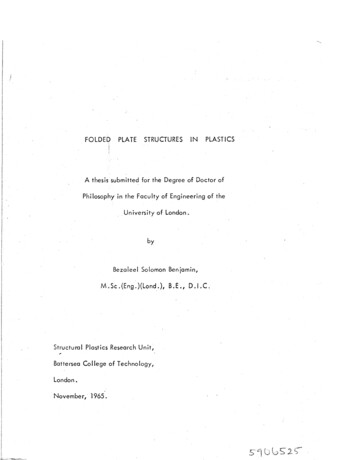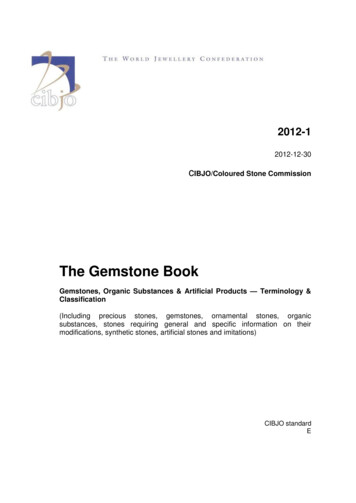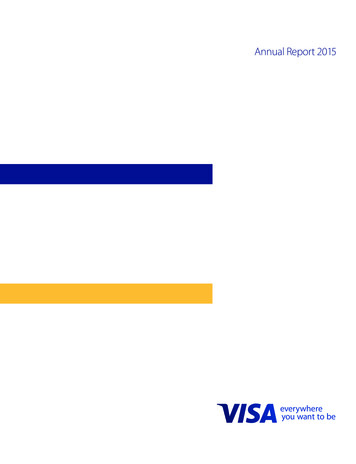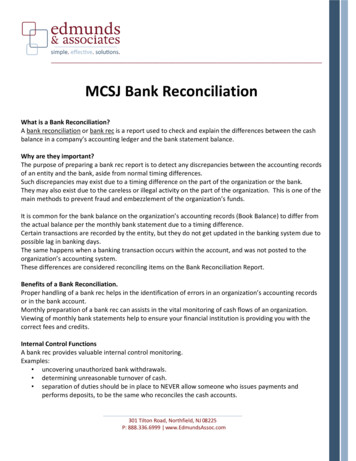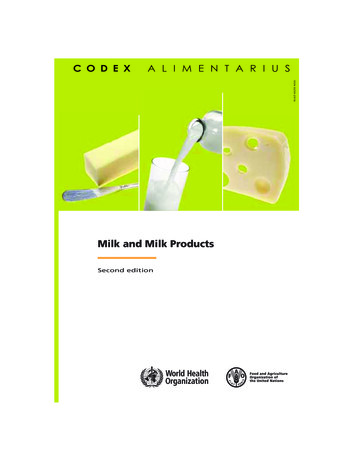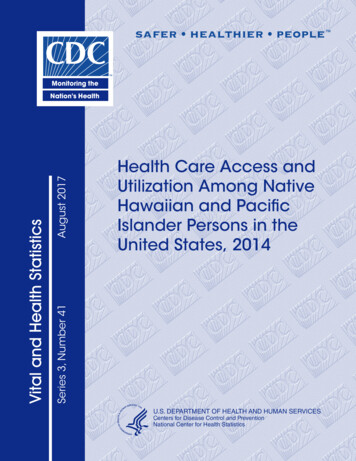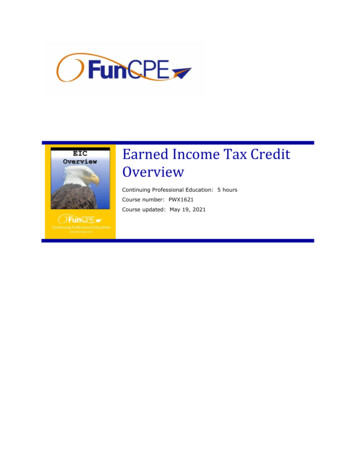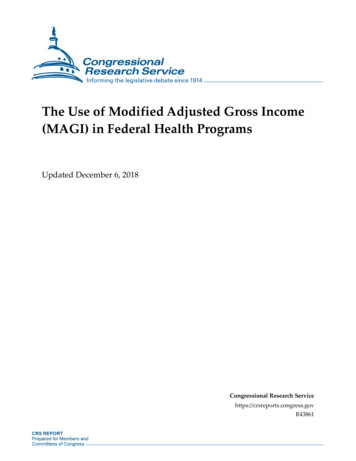
Transcription
The Use of Modified Adjusted Gross Income(MAGI) in Federal Health ProgramsUpdated December 6, 2018Congressional Research Servicehttps://crsreports.congress.govR43861
The Use of Modified Adjusted Gross Income (MAGI) in Federal Health ProgramsSummaryCertain portions of federal health programs rely on means testing for eligibility and otherpurposes. Medicare premiums, the individual mandate exemptions and penalties, eligibility andamounts for tax credits for health insurance exchange coverage, and Medicaid eligibility aredetermined, in part, using modified adjusted gross income (MAGI). MAGI is a concept that isused throughout federal tax law and certain federal programs. There is no uniform definition ofMAGI; rather, the term has different definitions depending on the purpose for which it is beingcalculated.For each of these federal health programs, MAGI begins with adjusted gross income (AGI) ascalculated for tax purposes. From there, various types of income are included (or, in the case ofMedicaid, subtracted) to calculate MAGI for each particular program. The different healthprograms do not necessarily define household income using the same groupings of people. Forexample, married couples living together are counted as the same Medicaid household regardlessof whether they file a joint tax return. By contrast, married couples must file a joint tax return tobe eligible for premium credits.The Patient Protection and Affordable Care Act (ACA; P.L. 111-148, as amended) establishedSection 36B of the Internal Revenue Code (IRC) to authorize a tax credit to assist eligibletaxpayers with the purchase of coverage through health insurance exchanges. “Householdincome” is used, among other factors, to determine eligibility for and amount of the premium taxcredit. IRC Section 36B includes a definition of household income, which is calculated using theMAGI amount (subject to certain adjustments) for eligible taxpayers and tax dependents.The MAGI definition in IRC Section 36B also is used as a basis in determining (1) whether anindividual is exempted from the individual mandate, (2) the penalty amount owed if a person doesnot comply with the individual mandate, and (3) Medicaid income eligibility for certainpopulations. However, in each case the MAGI definition in IRC Section 36B is modifieddifferently. Finally, a MAGI definition that differs from that in IRC Section 36B is used todetermine which Medicare beneficiaries pay high-income premiums.This report explores the different MAGI definitions across health programs, including Medicare,the individual mandate, premium tax credits on the health insurance exchanges, and Medicaid. Italso addresses why MAGI is used and how it is applied, specific to each program.Congressional Research Service
The Use of Modified Adjusted Gross Income (MAGI) in Federal Health ProgramsContentsIntroduction . 1Definition of MAGI in Health Programs . 1Medicare Income-Related Premiums . 4Determination of Income . 5Individual Mandate. 6Determination of Income . 6Exchanges and Premium Tax Credits . 7Determination of Income . 8Medicaid . 9Determination of Income . 9Transition to MAGI . 10How MAGI Is Applied in Medicaid . 10MAGI-Exempted Groups.11Countable Income .11Family Size and Total Household Income . 12TablesTable 1. Additions and Subtractions to Federal Adjusted Gross Income (AGI) to CalculateModified Adjusted Gross Income (MAGI) for Health Programs . 2Table A-1. Medicaid MAGI-Based Eligibility Categories, Beginning January 1, 2014 . 14Table A-2. MAGI-Excepted Eligibility Categories, Beginning January 2014 . 15AppendixesAppendix. MAGI and Medicaid’s Eligibility Categories . 14ContactsAuthor Information. 19Acknowledgments . 19Congressional Research Service
The Use of Modified Adjusted Gross Income (MAGI) in Federal Health ProgramsIntroductionCertain portions of federal health programs rely on means testing for eligibility and otherpurposes. Medicare premiums, the individual mandate exemptions and penalties, eligibility andamounts for tax credits for health insurance exchange coverage, and Medicaid eligibility aredetermined, in part, using modified adjusted gross income (MAGI). MAGI is a concept that isused throughout federal tax law and certain federal programs. However, there is no uniformdefinition of MAGI; rather, the term has different definitions depending on the purpose for whichit is being calculated.For each of these federal health programs—Medicare, the individual mandate, premium taxcredits on the health insurance exchanges, and Medicaid—MAGI begins with adjusted grossincome (AGI) as calculated for tax purposes. From there, various types of income are included(or, in the case of Medicaid, subtracted) to calculate MAGI for each particular program. Inaddition, the different health programs do not necessarily define household income using thesame groupings of people. For example, married couples living together are counted as the sameMedicaid household regardless of whether the married individuals file a joint tax return. Bycontrast, married couples must file a joint tax return to be eligible for premium credits.The Patient Protection and Affordable Care Act (ACA; P.L. 111-148, as amended) establishedSection 36B of the Internal Revenue Code (IRC) to authorize a tax credit to assist eligibletaxpayers with the purchase of coverage through health insurance exchanges. “Householdincome” is used, among other factors, to determine eligibility for and amount of the premium taxcredit. IRC Section 36B includes a definition of household income, which is calculated using theMAGI amount (subject to certain adjustments) for eligible taxpayers and tax dependents.The MAGI definition in IRC Section 36B also is used as a basis in determining (1) whether anindividual is exempted from the individual mandate, (2) the penalty amount owed if a person doesnot comply with the individual mandate, and (3) Medicaid income eligibility for certainpopulations. However, in each case the MAGI definition in IRC Section 36B is modifieddifferently. Finally, a MAGI definition that differs from that in IRC Section 36B is used todetermine which Medicare beneficiaries pay high-income premiums.This report explores the different MAGI definitions across health programs, including Medicare,the individual mandate, premium tax credits on the health insurance exchanges, and Medicaid. Italso addresses why MAGI is used and how it is applied, specific to each program.Definition of MAGI in Health Programs1The health programs discussed in this report use MAGI to make eligibility and otherdeterminations. MAGI is a concept used throughout federal tax law and certain federal programs.There is no uniform definition of MAGI; rather, the term is defined differently depending on thepurpose for which it is being used.The starting point for calculating MAGI is always AGI.2 Unlike MAGI, only one definition ofAGI exists in federal law, and it is found in IRC Section 62. Under IRC Section 62, AGI iscalculated by subtracting allowable adjustments (commonly referred to as above-the-linedeductions) from gross income. Gross income is “all income from whatever source derived”12Brian T. Yeh authored this section of the report.26 U.S.C. §62.Congressional Research ServiceR43861 · VERSION 11 · UPDATED1
The Use of Modified Adjusted Gross Income (MAGI) in Federal Health Programsunless otherwise excepted.3 Exceptions include gifts, inheritances, interest on state and localbonds, a portion of Social Security benefits received, and some income earned in foreigncountries or U.S. territories. Examples of above-the-line deductions include deductions forpenalties on early withdrawal of savings, student loan interest paid, and health savings accountcontributions.4 When these deductions are subtracted from gross income, the result is AGI. This isthe amount found on the bottom line of the first page of IRS Form 1040 (Individual Income TaxReturn).As mentioned, although MAGI is used in various provisions in federal law, the modificationsmade to AGI differ depending on the specific law or program. For the health programs discussedin this report, MAGI begins with AGI. From there, various types of income not included in AGIare added to calculate MAGI for each particular program. Additionally, under Medicaid statuteand regulations, particular types of income included in AGI may be subtracted to calculate MAGIfor determining Medicaid eligibility.5 Table 1 summarizes the additions and subtractions to AGIthat are used to calculate MAGI for various health programs. These adjustments are discussed indetail in the “Medicare Income-Related Premiums,” “Individual Mandate,” “Exchanges andPremium Tax Credits,” and “Medicaid” sections of this report.Table 1. Additions and Subtractions to Federal Adjusted Gross Income (AGI) toCalculate Modified Adjusted Gross Income (MAGI) for Health ProgramsModified Adjusted Gross IncomeACA dicaidEligibilityaAdded toAGIAdded toAGIAdded toAGIAdded toAGIAdded toAGIAdded toAGIAdded toAGIAdded toAGIAdded toAGIAdded toAGIAdded toAGIAdded toAGIAdded toAGIAdded toAGIAdded toAGIAdded toAGIMedicarePremiumsExemptionbAdded toAGIInterest from U.S. savings bonds usedto pay higher education tuition andfeeseEarned income of U.S. citizens livingabroad that was excluded from grossincomefDescription of IncomeTax-exempt interest incomereceived or accrued (e.g., interestfrom state and local bonds)dNon-taxable portion of SocialSecurity benefitsgIncome from sources within Guam,American Samoa, the NorthernMariana Islands,h or Puerto Rico,i nototherwise included in AGIAdded toAGI326 U.S.C. §61.The 2017 tax revision, P.L. 115-97, made changes to certain above-the-line deductions, such as temporarily repealingthe deduction for moving expenses (other than for members of the Armed Forces). For further information, see CRSReport R45092, The 2017 Tax Revision (P.L. 115-97): Comparison to 2017 Tax Law.5 Per State Children’s Health Insurance Program (CHIP) regulations at 42 C.F.R. §457.315, the Medicaid MAGI rulesat 42 C.F.R. 435.603 subsections (b) through (i) also apply to CHIP.4Congressional Research ServiceR43861 · VERSION 11 · UPDATED2
The Use of Modified Adjusted Gross Income (MAGI) in Federal Health ProgramsModified Adjusted Gross IncomeACA IndividualMandateDescription of IncomeRequired contributions madethrough a salary reductionarrangement that are excluded fromgross CreditInitialMedicaidEligibilityaAdded toAGICertain types of irregular incomereceived as a lump sum and includedin AGI (e.g., state income tax refundor one-time gifts or inheritances)jIncluded inmonthlyAGI only inmonthreceivedk“Qualified lottery winnings” and/or“qualified lump sum income”lAmountsless than 80thousandincluded inAGI only inthe monthreceived;otheramountsproratedover aspecifiedperiodCertain payments to AmericanIndians and Alaska Natives if includedin AGImSubtractedfrom AGICertain scholarships, awards, andfellowship grants if included in AGInSubtractedfrom AGICompensation for parent mentorsunder Medicaid outreach andenrollment grantsoSubtractedfrom AGISource: Congressional Research Service, compilation from sources within the U.S. Code and Regulations.Current as of the date of this report.a. “Initial” Medicaid Eligibility refers to eligibility rules that apply to applicants and new enrollees (i.e., notcurrent enrollees seeking an eligibility redetermination).b. 26 U.S.C §5000A(e)(1).c. 26 U.S.C. §5000A(c)(4)(C).d. 26 U.S.C. §103.e. 26 U.S.C. §135.f.26 U.S.C. §911.g. The Three Percent Withholding Repeal and Job Creation Act (P.L. 112-56) changed the definition of incomefor the purposes of determining eligibility for ACA premium credits and Medicaid to include non-taxablesocial security benefits.h. 26 U.S.C. §931.i.26 U.S.C. §933.j.42 C.F.R. §435.603(h)(1).Congressional Research ServiceR43861 · VERSION 11 · UPDATED3
The Use of Modified Adjusted Gross Income (MAGI) in Federal Health Programsk.l.m.n.o.Under Medicaid, income eligibility for applicants and new enrollees is based on current monthly householdincome (see 42 C.F.R. §435.603(h)(1)). By contrast, when redetermining eligibility for current Medicaidenrollees, states are permitted to use current monthly income and family size, or projected annual incomeand family size for the remaining months of the calendar year (see 42 C.F.R. §435.603(h)(2)).U.S.C. 1396a(e)(14)(K). The Bipartisan Budget Act of 2018 (P.L. 115-123) requires states to consider“qualified lottery winnings” and “qualified lump sum” income when determining Medicaid eligibility forcertain individuals. The law defines “qualified lottery winnings” as winnings (including amounts awarded as alump sum payment) from a state-conducted sweepstakes or lottery, or a lottery operated by a multistate ormultijurisdictional lottery association. The law defines “qualified lump sum” income as income received as alump sum from monetary winnings from gambling (as defined by the Secretary of Health and HumanServices and including monetary winnings from gambling activities described in section 1955(b)(4) of title 18of the U.S. Code).42 C.F.R. §435.603(e)(3).42 C.F.R. §435.603(e)(2). See also 45 C.F.R. §233.20.42 U.S.C. 1396a(e).Medicare Income-Related Premiums6Medicare is a federal insurance program that pays for covered health services for most personsaged 65 and older, and for most permanently disabled individuals under the age of 65. Theprogram consists of four distinct parts: (1) Part A, which covers inpatient services; (2) Part B,which covers physician and outpatient services; (3) Part C (Medicare Advantage), a private healthplan option that covers most Part A and B services; and (4) Part D, which covers outpatientprescription drugs. Eligibility for Medicare is not based on income. Most individuals are eligiblefor premium-free Part A if they or their spouse paid Medicare payroll taxes for at least 40quarters. Parts B and D are optional and require the payment of premiums. Those premiums aremeans tested, and the income levels used to determine the premiums are based on a uniqueMedicare definition of MAGI.For the first 41 years of the Medicare program, all Part B enrollees paid the same Part B premiumamounts regardless of their income. However, the Medicare Modernization Act of 2003 (MMA;P.L. 108-173)7 required that, beginning in 2007, higher-income enrollees pay higher premiums.The ACA imposed similar high-income premiums for Medicare Part D prescription drug benefitenrollees beginning in 2011. The Centers for Medicare & Medicaid Services (CMS) estimatesthat about 5% of Medicare beneficiaries pay these higher premiums.8For Medicare Part B, standard premiums are set at 25% of average annual per capita Part Bprogram expenditures.9 Under Part D, base premiums are set at 25.5% of expected per capitacosts for basic Part D coverage.10 Adjustments are made to the Parts B and D premiums forhigher-income beneficiaries, with the percentage of per capita expenditures paid by these6Patricia A. Davis authored this section of the report.The Medicare Modernization Act of 2003 (MMA; P.L. 108-173) would have phased in the increase over five years;however, the Deficit Reduction Act of 2005 (DRA, P.L. 109-171) shortened the phase-in period to three years.8 See Centers for Medicare & Medicaid Services, “2019 Medicare Parts A & B Premiums and Deductibles,” fact sheet,October 12, 2018, at care-parts-b-premiums-and-deductibles.9 In 2019, the standard monthly Part B premium will be 135.50; however, about 3.5% of Part B enrollees are expectedto be protected by a “hold-harmless” provision and will pay a lower amount. For additional information on Part Bpremiums, see CRS Report R40082, Medicare: Part B Premiums.10 In 2019, the base monthly Part D premium will be 33.19; however, actual premiums paid by beneficiaries may varydepending on the prescription drug plan that they select. The hold-harmless provision does not apply to Part Dpremiums. See CRS Report R40611, Medicare Part D Prescription Drug Benefit.7Congressional Research ServiceR43861 · VERSION 11 · UPDATED4
The Use of Modified Adjusted Gross Income (MAGI) in Federal Health Programsbeneficiaries increasing with income. This percentage ranges from 35% to 85% of average percapita expenditures for both Parts B and D.11 In 2019, individuals whose income exceeds 85,000, and couples whose income exceeds 170,000, will be subject to higher premiumamounts.12Determination of IncomeTo determine which Medicare beneficiaries pay high-income premiums, the Social SecurityAdministration uses the most recent federal tax return provided by the IRS. The incomedeterminations are based on an individual’s tax filing status (i.e., individual filing, joint filing, ormarried filing separately).13 The income definition on which these determinations are based isMAGI,14 which is defined differently under Medicare than under other programs. Section1839(i)(4) of the Social Security Act (SSA) defines MAGI for this purpose as adjusted grossincome increased by the amount of certain other income that is exempt from tax under the IRC.15For the purpose of identifying who is required to pay high-income Medicare premiums, MAGI isdefined as the sum of (as defined in Table 1): the beneficiary’s AGI, pluscertain income exempt from tax under the IRC,16 including tax-exempt interest income received or accrued (e.g., interest from state andlocal bonds); interest from U.S. savings bonds used to pay higher education tuition andfees; earned income of U.S. citizens living abroad that was excluded from grossincome; income from sources within Guam, American Samoa, the Northern MarianaIslands, or Puerto Rico, not otherwise included in AGI.If a Medicare beneficiary had a one-time increase in taxable income in a particular year (e.g.,from the sale of income-producing property), that increase would be considered in determining11In 2019, there will be five high-income premium tiers; depending on income, beneficiaries can pay 35%, 50%, 65%,80% or 85% of per capita Parts B or D expenditures. For additional information, see Social Security Administration,Medicare Premiums: Rules for Higher-Income Beneficiaries, at http://www.ssa.gov/pubs/EN-05-10536.pdf.12 §3402 of the Patient Protection and Affordable Care Act (ACA; P.L. 111-148, as amended) froze the thresholds usedto determine high-income premiums at the 2010 level. These levels were maintained through 2017. In 2018 and 2019,§402 of the Medicare Access and CHIP Reauthorization Act of 2015 (P.L. 114-10) maintains the freeze on the incomethresholds for the lower two high-income premium tiers but reduces the threshold levels for the two highest incometiers so that more beneficiaries will fall into the higher percentage categories. Beginning in 2020, the thresholds will beadjusted annually for inflation. See CRS Report R43962, The Medicare Access and CHIP Reauthorization Act of 2015(MACRA; P.L. 114-10).13 Centers for Medicare & Medicaid Services, “Medicare Program: Medicare Part B Monthly Actuarial Rates, PremiumRate, and Annual Deductible Beginning January 1, 2019,” 83 Federal Register 52462, October 17, 2018, 2018-22530.pdf.14 See also Social Security Program Operations Manual, HI 01101.010, “Modified Adjusted Gross Income (MAGI),” 5 The Parts B and D high-income premium determinations are based on the same definition of MAGI. Specifically, theSocial Security Act §1860D-13(a)(7)(C) states that MAGI has the same meaning for Part D as it does for Part B asdefined in §1839(i)(4).16 20 C.F.R. §418.1010(b)(6).Congressional Research ServiceR43861 · VERSION 11 · UPDATED5
The Use of Modified Adjusted Gross Income (MAGI) in Federal Health Programsthe individual’s total income for that year, and the beneficiary could thus be subject to theincome-related premium two years ahead. It would not be considered in the calculations forfuture years. In the case of certain major life-changing events that result in a significant reductionin MAGI,17 an individual may request to have the determination made for a more recent year thanthe second preceding year.18Individual Mandate19The ACA required most individuals to maintain health insurance coverage or otherwise pay apenalty.20 Certain individuals are exempt from the individual mandate. For example, individualswith qualifying religious exemptions and those for whom health insurance coverage is“unaffordable” will not be subject to the mandate or its associated penalty. Individuals who do notmaintain health insurance coverage and are not exempt from the mandate will have to pay apenalty for each month of noncompliance. The penalty is assessed through the federal tax filingprocess; any penalty that taxpayers are required to pay for themselves or their dependents must beincluded in their return for that taxable year.The individual mandate was modified under the 2017 tax revision, P.L. 115-97, which wasenacted on December 22, 2017. The law effectively eliminates the penalty associated with theindividual mandate beginning in 2019 (i.e., the penalty is in effect through 2018). However, the2017 tax revision does not make any other substantive changes to the statutory languageestablishing the mandate and its associated penalty.Determination of IncomeAn individual’s household income is used to determine any penalty amounts owed, and it is usedto determine whether an individual is eligible for certain exemptions from the individual mandate.With respect to the individual mandate, household income is defined as the MAGI of thetaxpayer, plus the aggregate MAGI of all other individuals for whom the taxpayer is allowed adeduction for personal exemptions for the taxable year.21 As shown in Table 1, MAGI for thepurposes of the individual mandate is AGI increased by tax-exempt interest income received oraccrued, interest from U.S. savings bonds used to pay higher education tuition and fees, andearned income of U.S. citizens living abroad that was excluded from gross income.2217Major life-changing events include (1) death of a spouse; (2) marriage; (3) divorce or annulment; (4) partial or fullwork stoppage for the individual or spouse; (5) loss by individual or spouse of income from income-producing propertywhen the loss is not at the individual’s direction (e.g., a natural disaster); or (6) reduction or loss for individual orspouse of pension income due to termination or reorganization of the plan or scheduled cessation of the pension.(C.F.R. §418.1205.)18 Social Security Administration, “Medicare Income-Related Monthly Adjustment Amount—Life-Changing Event,”Social Security Form SSA-44, at http://www.ssa.gov/online/ssa-44.pdf.19 Ryan J. Rosso authored this section of the report.20 For more information about the individual mandate, see CRS Report R44438, The Individual Mandate for HealthInsurance Coverage: In Brief.21 26 U.S.C. §5000A(c)(4)(B). The individuals for whom a taxpayer is allowed a deduction for personal exemptions areidentified in 26 U.S.C. §151. Although P.L. 115-97 temporarily repealed the deduction for personal exemptionsthrough 2025, it expressly did not impact any other tax determination relying on, or referring to, personal exemptions.22 26 U.S.C. §5000A(c)(4)(C). P.L. 112-56, which changed the definition of income for the purposes of determiningeligibility for ACA premium credits and Medicaid to include nontaxable social security benefits, did not apply thechange to the individual mandate provision.Congressional Research ServiceR43861 · VERSION 11 · UPDATED6
The Use of Modified Adjusted Gross Income (MAGI) in Federal Health ProgramsFor individuals who do not maintain health insurance coverage and are not exempt from theindividual mandate, the penalty is based either on a formula or on a flat-dollar amount, whicheveris greater. The formula is a specific percentage multiplied by a person’s “applicable income.” Thepercentage is 2.5% in 2017 and 2018 and will be 0% for 2019 and beyond. An individual’s“applicable income” is defined as the amount by which an individual’s household incomeexceeds the applicable filing threshold for federal income taxes for the tax year.23 In other words,“applicable income” is the aggregate MAGI above the tax filing threshold for the taxpayer and alldependents required to file a tax return. The flat-dollar amount is 695 in 2017 and 2018,assessed for each taxpayer and any dependents.24 Beginning in 2019, the flat dollar amountpenalty will be 0.Certain individuals are exempt from the individual mandate and its associated penalty. One suchexample is for individuals for whom coverage is “unaffordable”; in 2018, coverage is consideredunaffordable if an individual’s required contribution for self-only coverage exceeds 8.05% of hisor her household income.25 For this exemption, household income is based on the same MAGIused to determine the penalty amount except that it also includes required contributions madethrough a salary reduction arrangement that are excluded from gross income.26 Individuals arealso exempt if their household income is less than the filing threshold for federal income taxes forthe applicable tax year.Exchanges and Premium Tax Credits27Health insurance exchanges operate in every state and the District of Columbia (DC), per theACA statute.28 Exchanges are not insurance companies; rather, they are “marketplaces” that offerprivate health plans to qualified individuals and small businesses. Given that the ACA specificallyrequires exchanges to offer insurance options to individuals and small businesses, exchanges arestructured to assist these two different types of “customers.” Consequently, there is an exchangeto serve individuals and families, and another to serve small businesses (“SHOP exchanges”),within each state.29Certain enrollees in the individual exchanges are eligible for premium assistance in the form offederal tax credits.30 Such credits are not provided through the SHOP exchanges. The premiumcredit is an advanceable, refundable tax credit, meaning tax filers need not wait until the end of23In 2018, the filing thresholds for most individuals under the age of 65 are 12,000 for a single filing status and 24,000 for most married couples filing jointly where both spouses are under the age of 65. The filing threshold islinked to an inflation adjustment based on the Chained Consumer Price Index for All Urban Consumers (C-CPI-U), andtherefore it may be higher in future years.24 When calculating the flat-dollar amount assessed on a taxpayer and his or her dependents, the flat-dollar amount isreduced by one-half for dependents under the age of 18 and the total family penalty is capped at 300% of the annualflat-dollar amount.25 In statute, the affordability threshold was set at 8% for 2014. The 8.05% threshold for 2018 is a result of the statutoryrequirement that the threshold percentage be adjusted in subsequent years to reflect the excess rate of premium growthabove the rate of income growth for the period.26 26 U.S.C. §5000A(e)(1).27 Bernadette Fernandez authored this section of the report.28 See Kaiser Family Foundation, “State Health Insurance Marketplace Profiles,” at es/.29 The ACA gives states the option to merge both exchanges and operate them under one structure.30 For additional information about the ACA’s premium tax credits, see CRS Report R44425, Health InsurancePremium Tax Credits and Cost-Sharing Subsidies.Congressional Research ServiceR43861 · VERSION 11 · UPDATED7
The Use of Modified Adjusted Gross Income (MAGI) in Federal Health Programsthe tax year to benefit from the credit, and they may claim the full credit amount even if they havelittle or no federal income tax liability.To be eligible for a premium credit through an individual exchange, a person
Dec 06, 2018 · The Use of Modified Adjusted Gross Income (MAGI) in Federal Health Programs Congressional Research Service R43861 · VERSION 11 · UPDATED 2 unless otherwise excepted.3 Exceptions include gifts, inheritances, interest on state and local bonds, a portion of Social Secu
